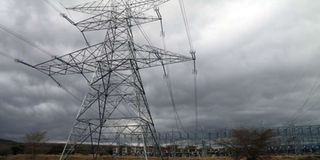Premium
Burden of unused power on consumers gets heavy

Pylons from the 220KV Suswa substation in Narok County.
What you need to know:
- Ketraco has also been putting up the 220-kilovolt Turkwel-Ortum - Kitale line to evacuate power from Turkwel, which has the cheapest hydro sources not sufficiently evacuated.
- The 90-kilometer line is expected to be completed in November 2021 just like the 132Kv Sondu-Ndhiwa line, which will evacuate another hydro power from Sondu.
Power consumers will continue to pay for idle electricity generated in various parts of the country unless major transmission lines are completed within deadlines.
Pressure is mounting on the Kenya Electricity Transmission Company (Ketraco) to expedite the projects critical to evacuation of growing installed capacity against a sluggish demand.
The country’s peak demand has hardly passed 1,900MW, meaning Kenya’s installed capacity of 2,766MW will need faster evacuation of cheaper sourced power such as geothermal and enable export so that consumers don’t have to pay for unused power.
Ketraco managing director Fernandes Barasa, however, maintains the firm is on track, with more than 25 major transmission lines across the country currently nearing completion.
“We have more than 2,400 kilometres of transmission lines being set up currently at a cost of Sh180 billion, including several substations. The infrastructure has so far grown from the 3,408 kilometres before Ketraco was established to the 8,468 kilometres we have currently,” Mr Barasa said.
Vandalism
Wayleave acquisition, delayed financing, vandalism and broke contractors remain some of the hurdles delaying completion of major power arteries that have left several consumers with inadequate supply as lots of power idles at the generation stations.
Some of the key power evacuation lines include the 300 kilometre Olkaria – Lessos – Kisumu line, which is said to be 80 per cent complete and which is now expected to be done in January, 2021. The line is key in evacuating cheaper geothermal power from Olkaria fields to western Kenya and to Uganda and Rwanda in the future.
The missing transmission has been behind unstable supply in Western, which relies on the 65MW generator in Muhoroni; an expensive source that affects all consumers since the cost of power is determined using what is used in the entire grid.
Western Kenya is also set to gain from the 68 kilometre Olkaria – Narok line, which is 77 percent complete and which may be operationalised this year to start supplying reliable power to Narok and future geothermal evacuation line to Southern Rift and Nyanza.
Ketraco has also been putting up the 220-kilovolt Turkwel-Ortum - Kitale line to evacuate power from Turkwel, which has the cheapest hydro sources not sufficiently evacuated. The 90-kilometer line is expected to be completed in November 2021 just like the 132Kv Sondu-Ndhiwa line, which will evacuate another hydro power from Sondu.
Spur economic growth
Twelve of the transmission lines currently at various stages of completion are targeted to spur economic growth through initiatives like irrigation and industrialisation, including 120km 132kV Sultan Hamud – Loitoktok line, which is expected to be completed by December 2021 and will supply reliable power to Loitoktok and cement factory in Merueshi.
The 240-kilometre Garsen – Hola – Bura – Garissa line, which has a similar completion timeline is expected to supply reliable power to Hola and Bura irrigation schemes.
The firm plans to set up more than 6,500 kilometres on new lines, with some 50 sub-stations to help run the high voltage transmission of power.
Kenya’s electricity consumption has not grown as was earlier projected, even as generation projects continued growth. The transmission infrastructure is among the key options left for the country to enable it sell the excess power in the region under the East African Power Pool plan (EAPP).
Ketraco is expected to complete three regional transmission lines by end of next year, including the one connecting Kenya and Ethiopia which is 98 per cent done, to enable Kenya start trading in electricity.
The 632 kilometre line running from the Sodo region in Ethiopia to Kenya’s Suswa substation is not only the longest transmission line so far but with the highest voltage at 500 kilovolts.
“This line will enable Kenya to start exchanging power with Ethiopia as we move closer to the EAPP programme, which supports the integration of power systems of five countries including Tanzania, Uganda and Rwanda with a combined population of over 200 million,” Mr Barasa said.





